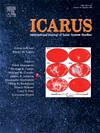The role of planetary-scale waves on the stratospheric superrotation in Titan's atmosphere
IF 2.5
2区 物理与天体物理
Q2 ASTRONOMY & ASTROPHYSICS
引用次数: 0
Abstract
We analyze simulation results from the TitanWRF global circulation model to understand the mechanisms that maintain the equatorial superrotation in Titan's stratosphere. We find that the eddies associated with wave activities can transport angular momentum upgradient to zonal flow, leading to acceleration of the equatorial superrotation. The dominant wave modes identified in this study are consistent with previous studies, with zonal wavenumber 1 being the major contributor to the prograde acceleration. Despite the same conclusion of maintenance of equatorial superrotation via wave-mean interactions, we find that the way waves interact with the zonal flow in TitanWRF is slightly different from some other studies. We confirm our previous findings that in TitanWRF this occurs primarily during a dozen or so annual, short-duration (a few Titan sols) angular momentum “transfer events,” which have a repeatable seasonal pattern but differ slightly in timing and magnitude between years. This is not the case in the Titan Atmosphere Model (TAM), which found milder angular momentum transfers that produced the strongest acceleration of superrotation around solstice in the upper stratosphere and more continuous year-around acceleration in the lower stratosphere. Despite differences in angular momentum transfer across models, we further find that, similar to the TAM wave analysis results, eddies generated by Rossby-Kelvin instabilities may be the major source of prograde angular momentum for the equatorial superrotation, although TitanWRF may also include contributions from the absorption of vertically propagating equatorial Kelvin waves. This differs from our previous work, which suggested barotropic waves were responsible for TitanWRF's solsticial transfer event.
求助全文
约1分钟内获得全文
求助全文
来源期刊

Icarus
地学天文-天文与天体物理
CiteScore
6.30
自引率
18.80%
发文量
356
审稿时长
2-4 weeks
期刊介绍:
Icarus is devoted to the publication of original contributions in the field of Solar System studies. Manuscripts reporting the results of new research - observational, experimental, or theoretical - concerning the astronomy, geology, meteorology, physics, chemistry, biology, and other scientific aspects of our Solar System or extrasolar systems are welcome. The journal generally does not publish papers devoted exclusively to the Sun, the Earth, celestial mechanics, meteoritics, or astrophysics. Icarus does not publish papers that provide "improved" versions of Bode''s law, or other numerical relations, without a sound physical basis. Icarus does not publish meeting announcements or general notices. Reviews, historical papers, and manuscripts describing spacecraft instrumentation may be considered, but only with prior approval of the editor. An entire issue of the journal is occasionally devoted to a single subject, usually arising from a conference on the same topic. The language of publication is English. American or British usage is accepted, but not a mixture of these.
 求助内容:
求助内容: 应助结果提醒方式:
应助结果提醒方式:


